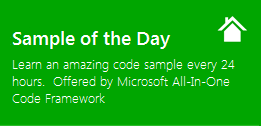[Sample of Feb 23rd] Save a DIB on the Clipboard to a File using Silverlight 5
 |
 |
|
 |
 |
|
Sample Download: https://code.msdn.microsoft.com/CSTFSAddCheckOutEventType-673d0536
 Today’s code sample demonstrates accessing the Windows Clipboard and retrieving a Device Independent Bitmap (DIB) and saving the DIB to a file in Silverlight 5. If you are developing Silverlight applications or learning Silverlight 5, we hope that the Microsoft All-In-One Code Framework sample would reduce your effort in this typical Silverlight programming scenario.
Today’s code sample demonstrates accessing the Windows Clipboard and retrieving a Device Independent Bitmap (DIB) and saving the DIB to a file in Silverlight 5. If you are developing Silverlight applications or learning Silverlight 5, we hope that the Microsoft All-In-One Code Framework sample would reduce your effort in this typical Silverlight programming scenario.
The sample was written by Microsoft Senior Support Escalation Engineer Trevor Fellman.
 You can find more code samples that demonstrate the most typical programming scenarios by using Microsoft All-In-One Code Framework Sample Browser or Sample Browser Visual Studio extension. They give you the flexibility to search samples, download samples on demand, manage the downloaded samples in a centralized place, and automatically be notified about sample updates. If it is the first time that you hear about Microsoft All-In-One Code Framework, please watch the introduction video on Microsoft Showcase, or read the introduction on our homepage https://1code.codeplex.com/.
You can find more code samples that demonstrate the most typical programming scenarios by using Microsoft All-In-One Code Framework Sample Browser or Sample Browser Visual Studio extension. They give you the flexibility to search samples, download samples on demand, manage the downloaded samples in a centralized place, and automatically be notified about sample updates. If it is the first time that you hear about Microsoft All-In-One Code Framework, please watch the introduction video on Microsoft Showcase, or read the introduction on our homepage https://1code.codeplex.com/.
Introduction
This code sample demonstrates accessing the Windows Clipboard and retrieving a Device Independent Bitmap (DIB) and saving the DIB to a file.
Building the Sample
This Sample requires Silverlight 5 Tools for Visual Studio 2010 SP1.
Running the Sample
1. Set CSSL5DIBFromClipboard.Web to the startup project.
2. Set CSSL5DIBFromClipboardTestPage.html as the Start Page.
3. Build and Run the solution
4. Press "PrtScn" or copy a Bitmap to the clipboard using other means such as MSPaint
5. Press the "Save Bitmap on Clipboard to File" button
6. Use the SaveFileDialog to save the Bitmap to disk.

Using the Code
You can reuse this code if your application needs to attach bitmap data from the clipboard.
The following code snippet shows the wrapper class.
public static class NativeMethods
{
[DllImport("user32.dll", EntryPoint = "OpenClipboard", CharSet = CharSet.Auto, SetLastError = true)]
public static extern bool OpenClipboard(IntPtr hWndNewOwner);
[DllImport("user32.dll", EntryPoint = "CloseClipboard", CharSet = CharSet.Auto, SetLastError = true)]
public static extern bool CloseClipboard();
[DllImport("user32.dll", EntryPoint = "IsClipboardFormatAvailable", CharSet = CharSet.Auto, SetLastError = true)]
public static extern bool IsClipboardFormatAvailable(uint fmt);
[DllImport("user32.dll", EntryPoint = "GetClipboardData", CharSet = CharSet.Auto, SetLastError = true)]
public static extern IntPtr GetClipboardData(uint fmt);
[DllImport("kernel32.dll", CharSet = CharSet.Auto, SetLastError = true)]
[return: MarshalAs(UnmanagedType.Bool)]
public static extern bool CloseHandle(IntPtr hObject);
[DllImport("kernel32.dll", CharSet = CharSet.Auto, SetLastError = true)]
public static extern IntPtr GlobalLock(IntPtr hObject);
[DllImport("kernel32.dll", CharSet = CharSet.Auto, SetLastError = true)]
public static extern int GlobalSize(IntPtr hGlobal);
[DllImport("kernel32.dll", CharSet = CharSet.Auto, SetLastError = true)]
public static extern bool GlobalUnlock(IntPtr hObject);
// See https://msdn.microsoft.com/en-us/library/windows/desktop/ff729168(v=vs.85).aspx for clipboard formats
public const uint CF_DIB = 8;
}
The following code snippet shows the key point of this code sample.
private void SaveDIBOnClipboardToFile()
{
// Check to see if we've got trust
// https://msdn.microsoft.com/en-us/library/system.windows.application.haselevatedpermissions(v=vs.95).aspx
if (true == Application.Current.HasElevatedPermissions)
{
// Get Data off the Clipboard
bool res = NativeMethods.OpenClipboard(IntPtr.Zero);
if (NativeMethods.IsClipboardFormatAvailable(NativeMethods.CF_DIB))
{
// Save the clipboard data to this stream,
// the stream could also come from HttpWebRequest, File, or other source.
IntPtr clipboardDataHandle = NativeMethods.GetClipboardData(NativeMethods.CF_DIB);
IntPtr ptr = NativeMethods.GlobalLock(clipboardDataHandle);
byte[] buffer = HGlobalToByteArray(ptr);
NativeMethods.GlobalUnlock(clipboardDataHandle);
NativeMethods.CloseClipboard();
// Pick someplace to Save the File
SaveFileDialog sfd = new SaveFileDialog();
if (true == sfd.ShowDialog())
{
Stream fs = sfd.OpenFile();
WriteBitmapFileToStream(buffer, fs);
fs.Close();
fs.Dispose();
}
}
}
}
More Information
For more information please see the Trusted Applications topic for Silverlight in MSDN
https://msdn.microsoft.com/en-us/library/ee721083(v=VS.95).aspx
Using the Clipboard
https://msdn.microsoft.com/en-us/library/windows/desktop/ms649016(v=vs.85).aspx
Storing an Image
https://msdn.microsoft.com/en-us/library/dd145119(v=vs.85).aspx